Ask a question from expert
HND Safeguarding in Health and Social Care
32 Pages4769 Words410 Views
Added on 2020-11-23
HND Safeguarding in Health and Social Care
Added on 2020-11-23
BookmarkShareRelated Documents
HND Safeguarding in Health and Social Care
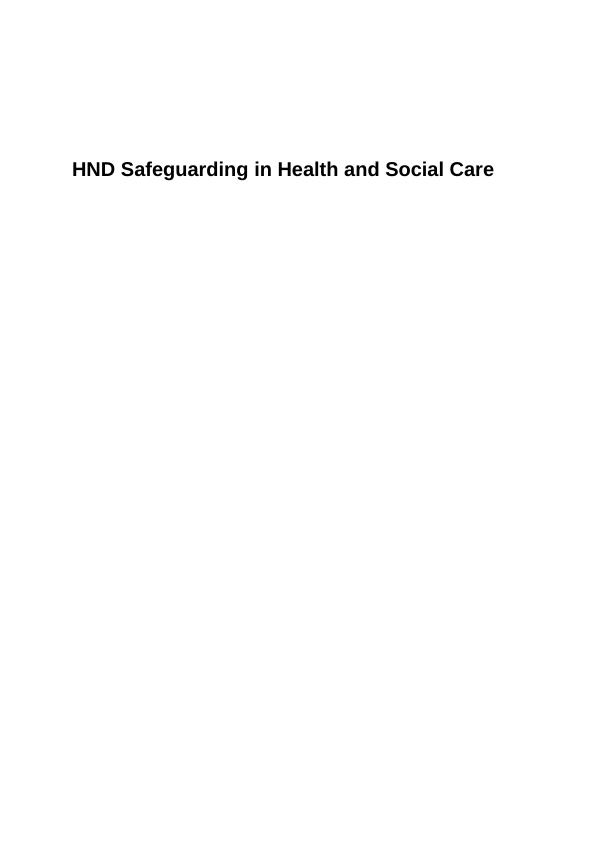
ContentsReport: Explanation of why particular individuals and groups maybe vulnerable to abuse and/or harm to self and others..................................1Campaign poster: Review of the risk factors which may lead to incidence ofabuse and/or harm to self and others...........................................................5Report: Analysis of the impact of social and cultural factors on different typesof abuse and/or harm to self and others.......................................................6Essay: Analysis of the strengths and weaknesses in current legislation andpolicy relating to those vulnerable to abuse.................................................7Report: How key professionals are involved in the protection of individualsand groups vulnerable to abuse.................................................................9Presentations:Explanation of existing working practices and strategies designed to minimiseabuse in health and social care contexts....................................................112
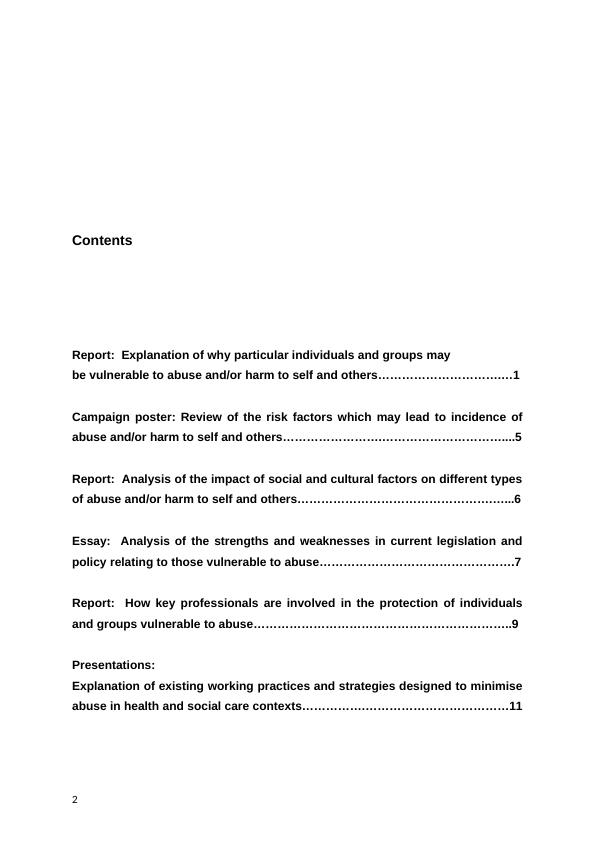
Evaluation of the effectiveness of working practices and strategies used tominimise abuse in health and social care contexts......................................16Discussion of the possible improvements to working practices and strategiesto minimise abuse in health and social care contexts..................................17Summary ...............................................................................................21References..............................................................................................223

Executive Summary This series of reports considers various aspects of safeguarding and abuse.“Safeguarding means protecting people's health, well-being and human rights, andenabling them to live free from harm, abuse and neglect. It is fundamental to high-quality health and social care” (REF). Since abuse is increasing on a global andnational level it is important that safeguarding is effective. Statistics from the WorldHealth Organisation indicate that approximately 1 in 10 older people are abusedevery month. “Rates of abuse may be higher for older people living in institutionsthan in the community. Elder abuse can lead to serious physical injuries and long-term psychological consequences. Elder abuse is predicted to increase as manycountries are experiencing rapidly ageing populations. The global population ofpeople aged 60 years and older will more than double, from 900 million in 2015 toabout 2 billion in 2050” (Elder abuse: WHO.int, 2017). These figures suggest thatthere are numerous problems in this area which have been highlighted in SeriousCase Reviews, two of which are discussed in the following reports. One reviewconcerns17-month-old Baby P. who was abused and murdered by his carers. Theother is Winterbourne View Hospital where patients and clients with neurological(dementia) or learning disabilities were systematically mentally and physicallyabused by staff.IntroductionSafeguarding is being considered as one of the effective factor or initiativetaken by government, health care providers and private firms put into action amonghealth and social care sector. They concern protecting vulnerable infants, youngchildren and adults through keeping them safe considering all the rights. Free fromdifferent harassments, neglects and so on. It means organisations work together toprevent the risk of abuse or neglect, and to stop them from happening. They ensurethat “people's well-being is promoted, taking their views, wishes, feelings and beliefsinto account” (Safeguarding people, CQC, 2016).Although safeguarding is the concern of health and social care agencies theireffectiveness in preventing various forms of abuse is questionable. This series of4
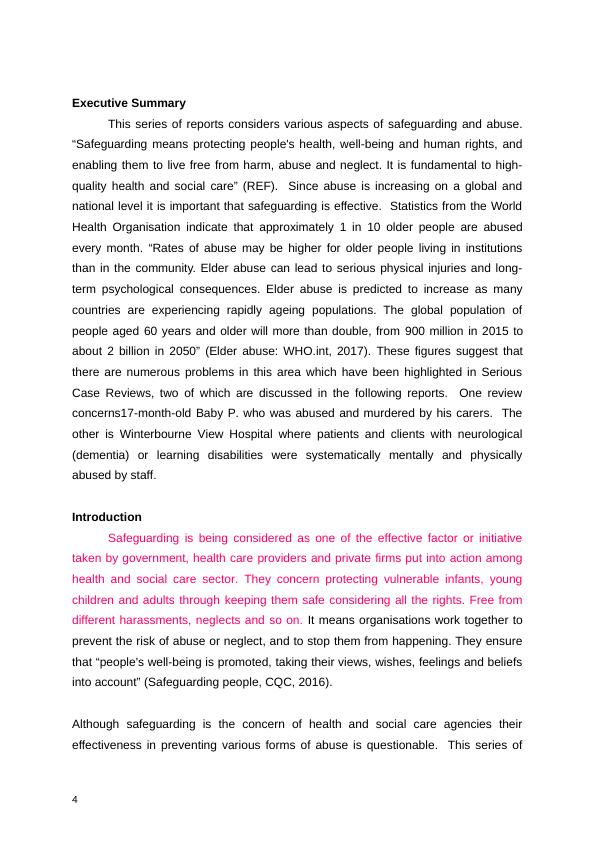
reports highlights where and why these problems occur, and how they can beaddressed now and in the future. Current legislation, policies, working practice andstrategies are also discussed with regard as a means of minimising abuse in healthand social care environs and in the home.This section of the report explains why particular individuals and groups may bevulnerable to abuse and/or harm to self and others. Numerous factors as to whyinfants, children and the elderly, those with mental and physically disabilities, may bevulnerable to abuse. Moreover, Jews, Mulims are often discriminated against as arethose from different ethnic groups. Abuse may consist of a “single act or repeated acts. It may be physical, verbal orpsychological, or an act of neglect or an omission to act, or it may occur in anyrelationship and may result in significant harm to, or exploitation of, the personsubject to it” (www.gov.uk).Two categories of persons and groups can be identified in terms of vulnerability toabuse. First category:This is consists of elderly people (usually over the age of 65)or infants and/or young children who suffer from any kind of mental orphysical disability. This can be considered in the case of Baby P. who waskilled by his carers. Baby P was particularly vulnerable as his carers camefrom a background of abuse. Indeed the stepfather was never identified bysocial services or other agencies as the partner of Baby P’s mother otherwisea DBS check would have been carried out on him.Second categoryis concerns vulnerability as it focuses on groups wherepeople from specific religion like Jews or Muslims are the focus ofdiscrimination by ‘outgroups’ (Sheldon, 2011). Mental and physical disablement often puts infants, young children andadults at risk of different forms of abuse, including discrimination. Researchhas shown that people can be excluded from work because of theirdisabilities. This can isolate them because of lack of education and work5
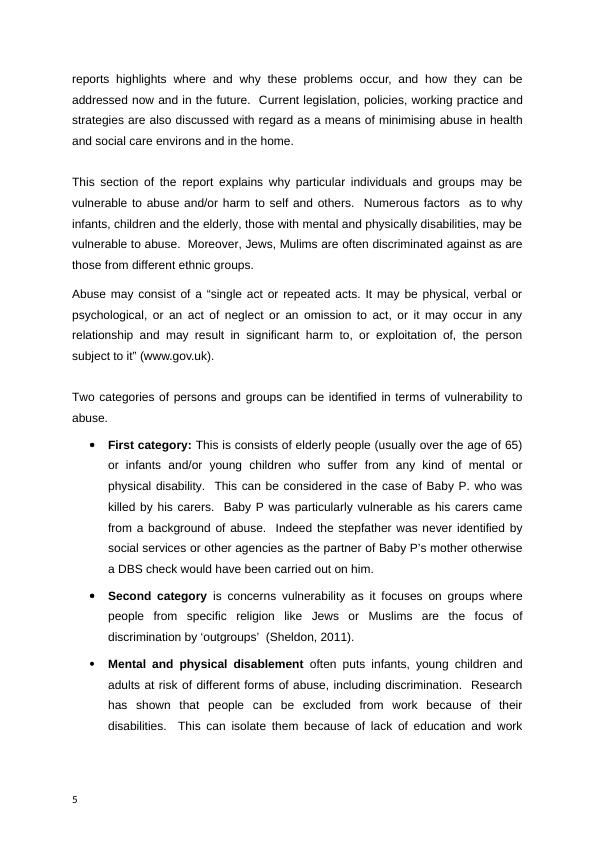
opportunities. These factors can lead to mental health problems (Brown,2009).Types of abuse Physical abuse is harm caused to someone physically in terms of bruises,bitting, broken bones, cuts and kicking. However, bruising can be disguisedby clothing, therefore abuse might not be so obvious. (Rasheed et al. 2010,p.238). In the case of Baby P was physically abuse regularly.6Serious Case Review: Baby P.“On 3 August 2007, 17-month-old Baby P, was found dead in his cot 48 hoursafter a doctor failed to spot the child’s severe injuries, including a broken spine.The baby was on Haringey Council’s child protection register throughout eightmonths of abuse in which he suffered more than 50 injuries – many of which hadbeen missed by Baby P’s doctor, social workers and the police. His family hadbeen seen 60 times by agencies, including social workers from Haringey Council.Peter’s step-father, Mr. H. and his brother, Mr. L. together with Ms. A., the child’smother, were responsible for Baby P’s death. Ms. A’s family background was oneof abuse where she and her brother witnessed domestic violence. She had anabsent father who was a sex offender, and a neglectful mother and anotherrelative who was lured into a paedophile ring in one of the biggest children'shome scandals of the late 20th century. As an adult Ms. A. stood by while herown son Baby P was subjected to months of abuse that eventually ended his life.On the other hand, Mr. H, was illiterate with an IQ of just 60), claimed he wasbullied as a youngster by his older brother, and in time turned abuser” (StudyNotes: Marchant-Haycox, 2018).
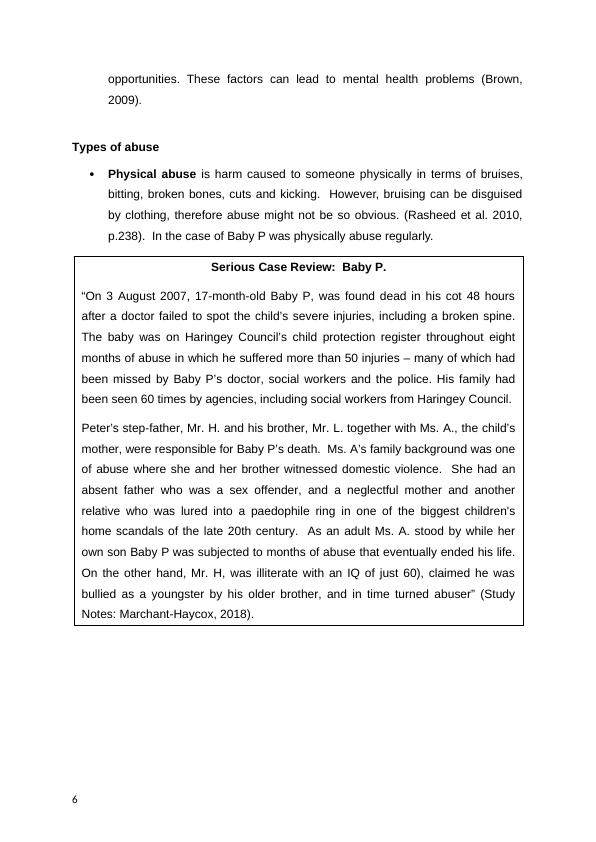
Sexual :- Self-harm is concerned with a person wilfully harming the self by cutting,bruising, burning parts of the body or self-poisoning. However, it is defined as the“intentional, direct injuring of body tissue most often done without suicidal intentions”(Self-harm: NHS, UK, n.d.). Often self-harm is used as a means of attractingattention. In other words it is a cry for help. SummaryIt is clear that particular individuals and groups may be more vulnerable to abusethan others. Age, mental and physical disabilities, religion and ethnicity are some ofthese factors.Campaign poster: review of the risk factors which may lead to incidence of abuse and/or harm to self and others7
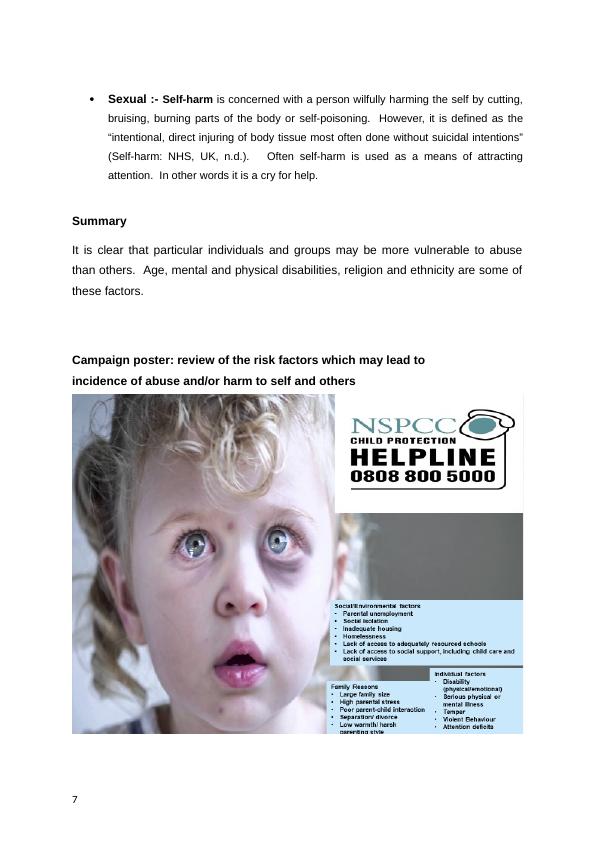
The above poster illustrates various factors (e.g. social, environmental, family, andindividual) are associated with vulnerability of abuse.“It may be physical, verbal or psychological, it may be an act of neglect or anomission to act, or it may occur in any relationship and may result in significant harmto, or exploitation of, the person subject to it” (No Secrets guidance,2018).IntroductionUnder this section of report, a basic analysis of impact of both cultural andsocial factors over various abuse or harm others and to self as well. Numerousfactors under this are given below:But, it is been found that mainly there are two factors like social and culturalwhich may impacts upon whole situation which is being faced by the patient. Inpresent context, baby was going through both physical and mental abuse. There area range of elements like mental health, social exclusion, education, access toresources, employment and disgrace of cultural factors like, religion, ethnicity andbeliefs that an individual is having something that mainly impact on individual'svulnerability and the way he negotiated with the abuse at the same time (Gagnonand Sabus, 2015).Poverty - This is being considered as one of the factor which could lead avulnerable to abuse. It has been found that, people that are coming underpoverty line mostly faces discrimination among public care services and theyare also not treated with the same aspect with equality and respect. Housing and Poorness - Poverty and housing also could lead an individualto feel irritated or it may enhance stress level as well through provokingrelated acts against him. This could lead him to raise a range of problems forhis wife, children or do self-harm as well.Education – It is also may be reason behind individual started abuse andphysical harm to Carers. Because illiteracy will be the major reason behindaggressive nature. Ms. A was poorly educated and her partner had an IQ of60.8

End of preview
Want to access all the pages? Upload your documents or become a member.
Related Documents
Safeguarding in Health and Social Carelg...
|31
|4402
|72
Safeguarding in HSC Assignmentlg...
|8
|2389
|31
Safeguarding in Health and Social Care Assignment - Moorwood Cottagelg...
|11
|3951
|97
Safeguarding in Health and Social Carelg...
|27
|5876
|347
Assignment on Safeguarding in Health & Social Carelg...
|8
|2112
|48
Safeguarding in Health and Social Care: Working Practices and Strategieslg...
|12
|1042
|94